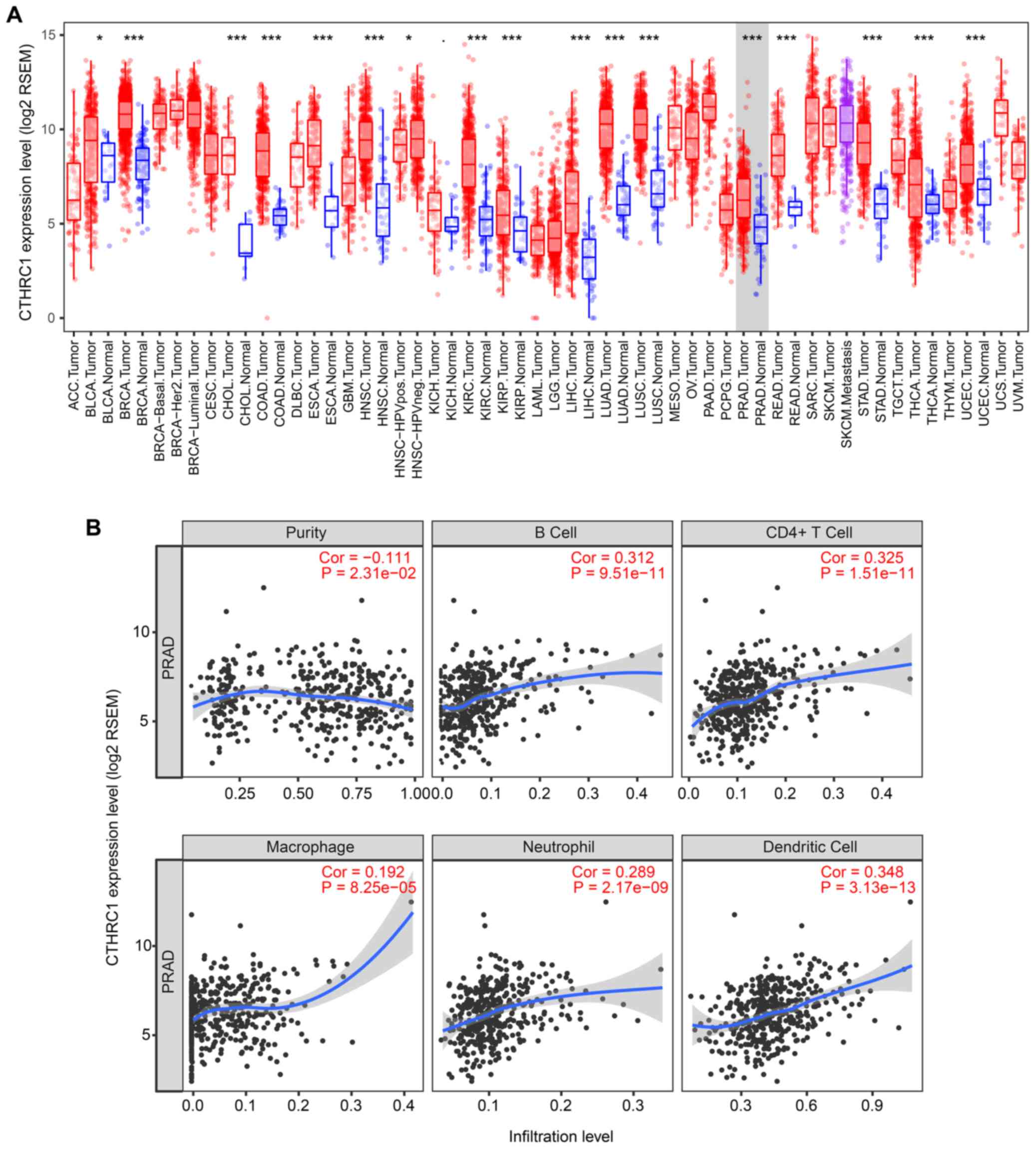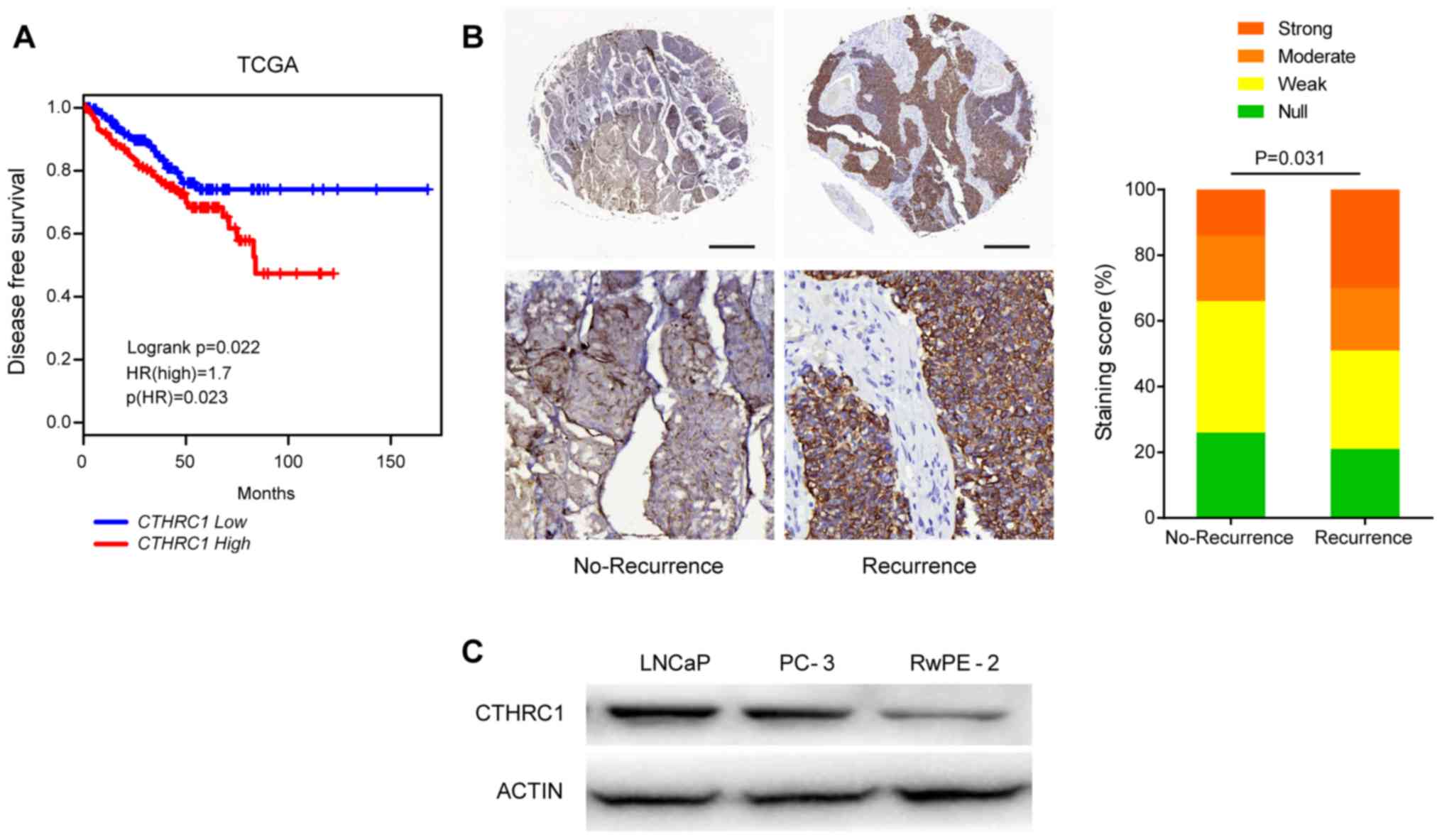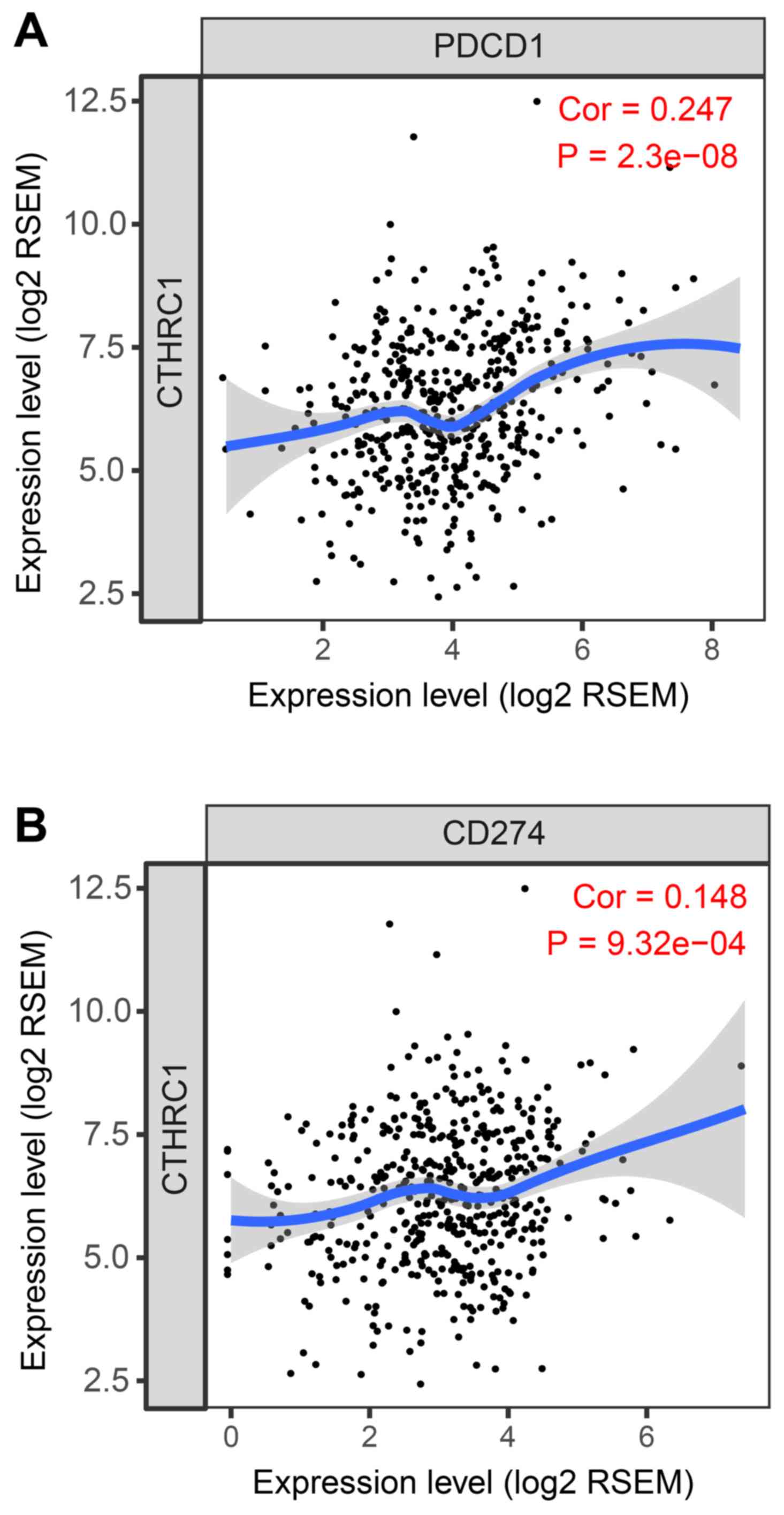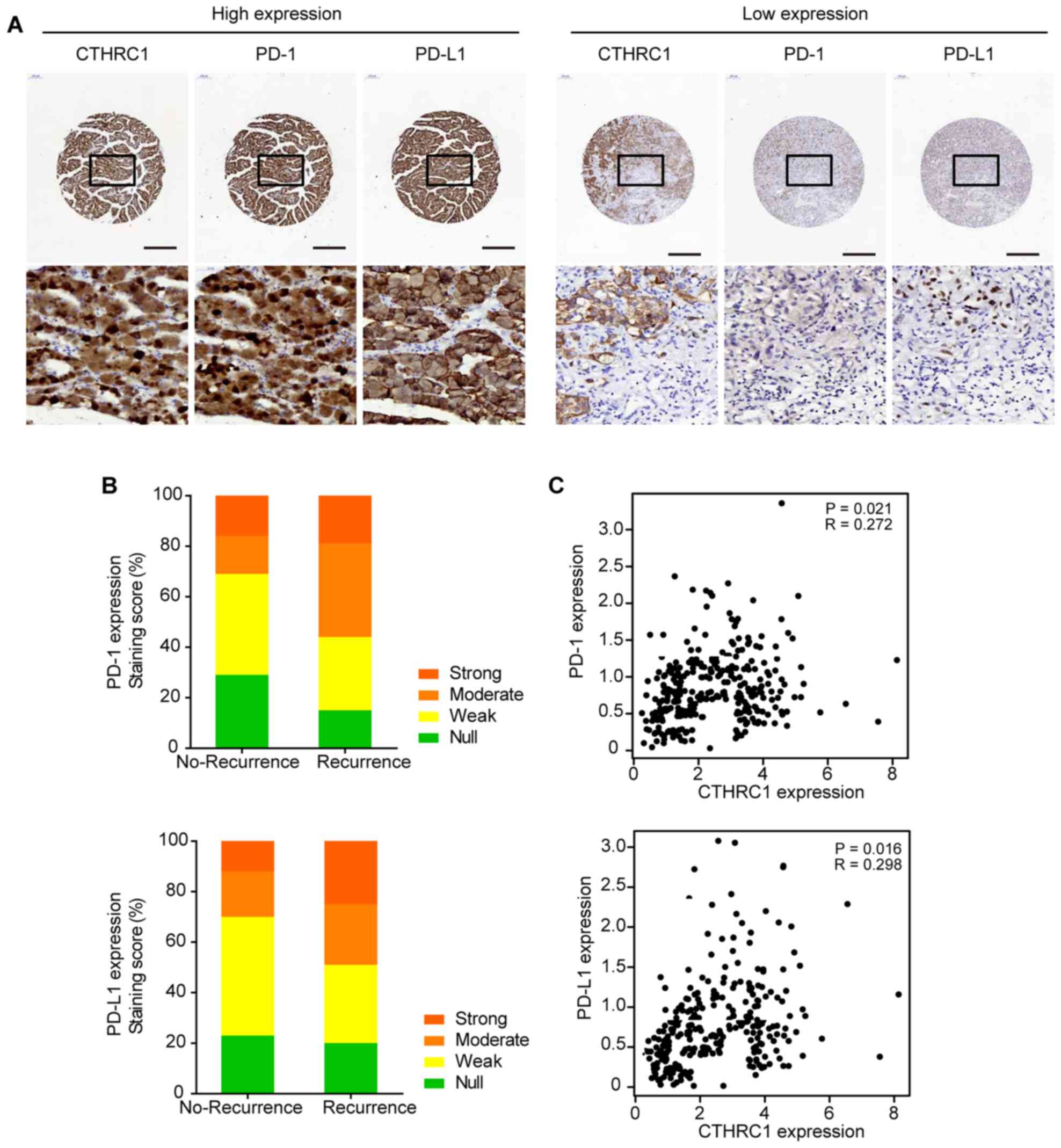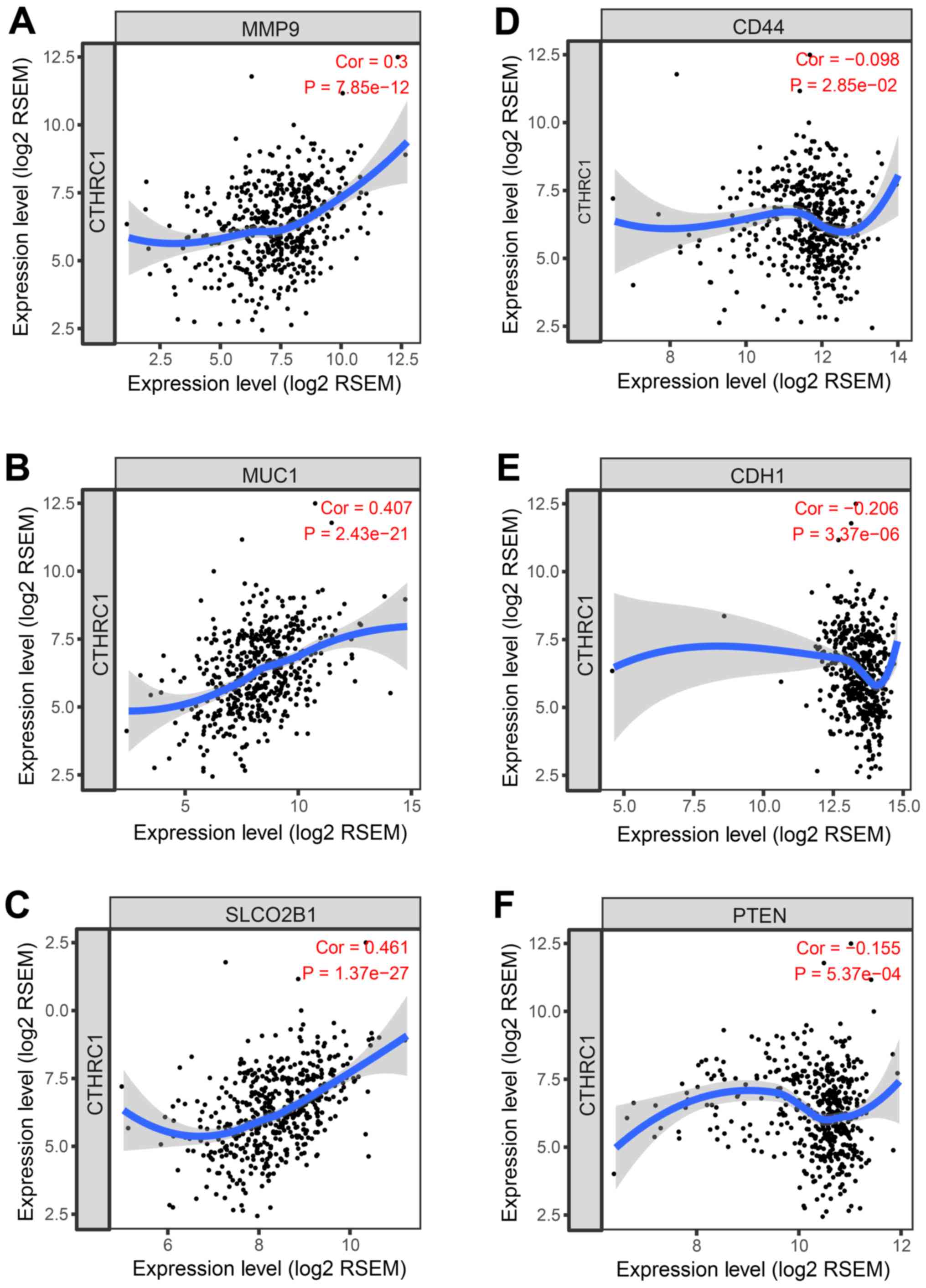|
1
|
Bray F, Ferlay J, Soerjomataram I, Siegel
R, Torre L and Jemal A: Global cancer statistics 2018: GLOBOCAN
estimates of incidence and mortality worldwide for 36 cancers in
185 countries. CA Cancer J Clin. 68:394–424. 2018. View Article : Google Scholar : PubMed/NCBI
|
|
2
|
Shiao SL, Chu GC and Chung LW: Regulation
of prostate cancer progression by the tumor microenvironment.
Cancer Lett. 380:340–348. 2016. View Article : Google Scholar : PubMed/NCBI
|
|
3
|
Dai J, Lu Y, Roca H, Keller JM, Zhang J,
McCauley LK and Keller ET: Immune mediators in the tumor
microenvironment of prostate cancer. Chin J Cancer. 36:292017.
View Article : Google Scholar : PubMed/NCBI
|
|
4
|
Lalonde E, Ishkanian A, Sykes J, Fraser M,
Ross-Adams H, Erho N, Dunning M, Halim S, Lamb AD, Moon NC, et al:
Tumour genomic and microenvironmental heterogeneity for integrated
prediction of 5-year biochemical recurrence of prostate cancer: A
retrospective cohort study. Lancet Oncol. 15:1521–1532. 2014.
View Article : Google Scholar : PubMed/NCBI
|
|
5
|
Shiao S, Chu G and Chung L: Regulation of
prostate cancer progression by the tumor microenvironment. Cancer
Lett. 380:340–348. 2016. View Article : Google Scholar : PubMed/NCBI
|
|
6
|
Bregni G, Rebuzzi S and Fornarini G:
Enzalutamide in castration-resistant prostate cancer. N Engl J Med.
379:1380–1381. 2018. View Article : Google Scholar : PubMed/NCBI
|
|
7
|
Zhang R, Lu H, Lyu YY, Yang XM, Zhu LY,
Yang GD, Jiang PC, Re Y, Song WW, Wang JH, et al:
E6/E7-P53-POU2F1-CTHRC1 axis promotes cervical cancer metastasis
and activates Wnt/PCP pathway. Sci Rep. 7:447442017. View Article : Google Scholar : PubMed/NCBI
|
|
8
|
Guo B, Yan H, Li L, Yin K, Ji F and Zhang
S: Collagen triple helix repeat containing 1 (CTHRC1) activates
Integrin β3/FAK signaling and promotes metastasis in ovarian
cancer. J Ovarian Res. 10:692017. View Article : Google Scholar : PubMed/NCBI
|
|
9
|
Yang XM, You HY, Li Q, Ma H, Wang YH,
Zhang YL, Zhu L, Nie HZ, Qin WX, Zhang ZG and Li J: CTHRC1 promotes
human colorectal cancer cell proliferation and invasiveness by
activating Wnt/PCP signaling. Int J Clin Exp Pathol. 8:12793–12801.
2015.PubMed/NCBI
|
|
10
|
Ma MZ, Zhuang C, Yang XM, Zhang ZZ, Ma H,
Zhang WM, You H, Qin W, Gu J, Yang S, et al: CTHRC1 acts as a
prognostic factor and promotes invasiveness of gastrointestinal
stromal tumors by activating Wnt/PCP-Rho signaling. Neoplasia.
16:265–278, 278.e1-e13. 2014. View Article : Google Scholar : PubMed/NCBI
|
|
11
|
Liu W, Fu X, Yang J, Yang M, Tao L, Liu D,
Huo Y, Zhang JF, Hua R and Sun YW: Elevated expression of CTHRC1
predicts unfavorable prognosis in patients with pancreatic ductal
adenocarcinoma. Am J Cancer Res. 6:1820–1827. 2016.PubMed/NCBI
|
|
12
|
Gu L, Liu L, Zhong L, Bai Y, Sui H, Wei X,
Zhang W, Huang P, Gao D, Kong Y and Lou G: Cthrc1 overexpression is
an independent prognostic marker in gastric cancer. Hum Pathol.
45:1031–1038. 2014. View Article : Google Scholar : PubMed/NCBI
|
|
13
|
Tameda M, Sugimoto K, Shiraki K, Yamamoto
N, Okamoto R, Usui M, Ito M, Takei Y, Nobori T, Kojima T, et al:
Collagen triple helix repeat containing 1 is overexpressed in
hepatocellular carcinoma and promotes cell proliferation and
motility. Int J Oncol. 45:541–548. 2014. View Article : Google Scholar : PubMed/NCBI
|
|
14
|
Wang C, Li Z, Shao F, Yang X, Feng X, Shi
S, Gao Y and He J: High expression of Collagen triple helix repeat
containing 1 (CTHRC1) facilitates progression of oesophageal
squamous cell carcinoma through MAPK/MEK/ERK/FRA-1 activation. J
Exp Clin Cancer Res. 36:842017. View Article : Google Scholar : PubMed/NCBI
|
|
15
|
Antonarakis E: Cyclin-dependent kinase 12,
immunity, and prostate cancer. N Engl J Med. 379:1087–1089. 2018.
View Article : Google Scholar : PubMed/NCBI
|
|
16
|
Taube J: Unleashing the immune system:
PD-1 and PD-Ls in the pre-treatment tumor microenvironment and
correlation with response to PD-1/PD-L1 blockade. Oncoimmunology.
3:e9634132014. View Article : Google Scholar : PubMed/NCBI
|
|
17
|
Shi X, Zhang X, Li J, Zhao H, Mo L, Shi X,
Hu Z, Gao J and Tan W: PD-1/PD-L1 blockade enhances the efficacy of
SA-GM-CSF surface-modified tumor vaccine in prostate cancer. Cancer
Lett. 406:27–35. 2017. View Article : Google Scholar : PubMed/NCBI
|
|
18
|
Tang Z, Li C, Kang B, Gao G and Zhang Z:
GEPIA: A web server for cancer and normal gene expression profiling
and interactive analyses. Nucleic Acids Res. 45:W98–W102. 2017.
View Article : Google Scholar : PubMed/NCBI
|
|
19
|
Li T, Fan J, Wang B, Traugh N, Chen Q, Liu
J, Li B and Liu XS: TIMER: A web server for comprehensive analysis
of tumor-infiltrating immune cells. Cancer Res. 77:e108–e110. 2017.
View Article : Google Scholar : PubMed/NCBI
|
|
20
|
Pierorazio PM, Walsh PC, Partin AW and
Epstein JI: Prognostic Gleason grade grouping: Data based on the
modified Gleason scoring system. BJU Int. 111:753–760. 2013.
View Article : Google Scholar : PubMed/NCBI
|
|
21
|
Epstein JI, Egevad L, Amin MB, Delahunt B,
Srigley JR and Humphrey PA; Grading Committee, : The 2014
international society of urological pathology (ISUP) consensus
conference on gleason grading of prostatic carcinoma: Definition of
grading patterns and proposal for a New Grading System. Am J Surg
Pathol. 40:244–252. 2016.PubMed/NCBI
|
|
22
|
Chaiswing L, Zhong W and Oberley TD:
Distinct redox profiles of selected human prostate carcinoma cell
lines: Implications for rational design of redox therapy. Cancers
(Basel). 3:3557–3584. 2011. View Article : Google Scholar : PubMed/NCBI
|
|
23
|
Haffner MC, Guner G, Taheri D, Netto GJ,
Palsgrove DN, Zheng Q, Guedes LB, Kim K, Tsai H, Esopi DM, et al:
Comprehensive evaluation of programmed death-ligand 1 expression in
primary and metastatic prostate cancer. Am J Pathol. 188:1478–1485.
2018. View Article : Google Scholar : PubMed/NCBI
|
|
24
|
Hahn E, Liu SK, Vesprini D, Xu B and
Downes MR: Immune infiltrates and PD-L1 expression in
treatment-naïve acinar prostatic adenocarcinoma: An exploratory
analysis. J Clin Pathol. 71:1023–1027. 2018. View Article : Google Scholar : PubMed/NCBI
|
|
25
|
He W, Zhang H, Wang Y, Zhou Y, Luo Y, Cui
Y, Jiang N, Jiang W, Wang H, Xu D, et al: CTHRC1 induces non-small
cell lung cancer (NSCLC) invasion through upregulating MMP-7/MMP-9.
BMC Cancer. 18:4002018. View Article : Google Scholar : PubMed/NCBI
|
|
26
|
Lin X, Gu Y, Kapoor A, Wei F, Aziz T, Ojo
D, Jiang Y, Bonert M, Shayegan B, Yang H, et al: Overexpression of
MUC1 and genomic alterations in its network associate with prostate
cancer progression. Neoplasia. 19:857–867. 2017. View Article : Google Scholar : PubMed/NCBI
|
|
27
|
Wang X, Harshman LC, Xie W, Nakabayashi M,
Qu F, Pomerantz MM, Lee GS and Kantoff PW: Association of SLCO2B1
genotypes with time to progression and overall survival in patients
receiving Androgen-deprivation therapy for prostate cancer. J Clin
Oncol. 34:352–359. 2016. View Article : Google Scholar : PubMed/NCBI
|
|
28
|
Gillard M, Lack J, Pontier A, Gandla D,
Hatcher D, Sowalsky AG, Rodriguez-Nieves J, Vander Griend D, Paner
G and VanderWeele D: Integrative genomic analysis of coincident
cancer foci implicates CTNNB1 and PTEN alterations in ductal
prostate cancer. Eur Urol Focus. 5:433–442. 2019. View Article : Google Scholar : PubMed/NCBI
|
|
29
|
Jamaspishvili T, Berman DM, Ross AE, Scher
HI, De Marzo AM, Squire JA and Lotan TL: Clinical implications of
PTEN loss in prostate cancer. Nat Rev Urol. 15:222–234. 2018.
View Article : Google Scholar : PubMed/NCBI
|
|
30
|
Kallakury BV, Sheehan CE and Ross JS:
Co-downregulation of cell adhesion proteins alpha- and
beta-catenins, p120CTN, E-cadherin, and CD44 in prostatic
adenocarcinomas. Hum Pathol. 32:849–855. 2001. View Article : Google Scholar : PubMed/NCBI
|
|
31
|
Woodson K, Hayes R, Wideroff L, Villaruz L
and Tangrea J: Hypermethylation of GSTP1, CD44, and E-cadherin
genes in prostate cancer among US Blacks and Whites. Prostate.
55:199–205. 2003. View Article : Google Scholar : PubMed/NCBI
|
|
32
|
Rajabi H, Ahmad R, Jin C, Joshi MD, Guha
M, Alam M, Kharbanda S and Kufe D: MUC1-C oncoprotein confers
androgen-independent growth of human prostate cancer cells.
Prostate. 72:1659–1568. 2012. View Article : Google Scholar : PubMed/NCBI
|
|
33
|
Baspinar S, Bircan S, Ciris M, Karahan N
and Bozkurt KK: Expression of NGF, GDNF and MMP-9 in prostate
carcinoma. Pathol Res Pract. 213:483–489. 2017. View Article : Google Scholar : PubMed/NCBI
|
|
34
|
Tang L, Dai DL, Su M, Martinka M, Li G and
Zhou Y: Aberrant expression of collagen triple helix repeat
containing 1 in human solid cancers. Clin Cancer Res. 12:3716–3722.
2006. View Article : Google Scholar : PubMed/NCBI
|
|
35
|
Wu Q, Yang Q and Sun H: Role of collagen
triple helix repeat containing-1 in tumor and inflammatory
diseases. J Cancer Res Ther. 13:621–624. 2017. View Article : Google Scholar : PubMed/NCBI
|
|
36
|
Duarte CW, Stohn JP, Wang Q, Emery IF,
Prueser A and Lindner V: Elevated plasma levels of the pituitary
hormone Cthrc1 in individuals with red hair but not in patients
with solid tumors. PLoS One. 9:e1004492014. View Article : Google Scholar : PubMed/NCBI
|
|
37
|
Taube JM, Klein A, Brahmer JR, Xu H, Pan
X, Kim JH, Chen L, Pardoll DM, Topalian SL and Anders RA:
Association of PD-1, PD-1 ligands, and other features of the tumor
immune microenvironment with response to anti-PD-1 therapy. Clin
Cancer Res. 20:5064–5074. 2014. View Article : Google Scholar : PubMed/NCBI
|
|
38
|
Herbst RS, Soria JC, Kowanetz M, Fine GD,
Hamid O, Gordon MS, Sosman JA, McDermott DF, Powderly JD, Gettinger
SN, et al: Predictive correlates of response to the anti-PD-L1
antibody MPDL3280A in cancer patients. Nature. 515:563–567. 2014.
View Article : Google Scholar : PubMed/NCBI
|
|
39
|
Shalapour S, Font-Burgada J, Di Caro G,
Zhong Z, Sanchez-Lopez E, Dhar D, Willimsky G, Ammirante M,
Strasner A, Hansel DE, et al: Immunosuppressive plasma cells impede
T-cell-dependent immunogenic chemotherapy. Nature. 521:94–98. 2015.
View Article : Google Scholar : PubMed/NCBI
|
|
40
|
Pan JH, Zhou H, Cooper L, Huang JL, Zhu
SB, Zhao XX, Ding H, Pan YL and Rong L: LAYN is a prognostic
biomarker and correlated with immune infiltrates in gastric and
colon cancers. Front Immunol. 10:62019. View Article : Google Scholar : PubMed/NCBI
|
|
41
|
Ni S, Ren F, Xu M, Tan C, Weng W, Huang Z,
Sheng W and Huang D: CTHRC1 overexpression predicts poor survival
and enhances epithelial-mesenchymal transition in colorectal
cancer. Cancer Med. 7:5643–5654. 2018. View Article : Google Scholar : PubMed/NCBI
|
|
42
|
Yan L, Yu J, Tan F, Ye GT, Shen ZY, Liu H,
Zhang Y, Wang JF, Zhu XJ and Li GX: SP1-mediated microRNA-520d-5p
suppresses tumor growth and metastasis in colorectal cancer by
targeting CTHRC1. Am J Cancer Res. 5:1447–1459. 2015.PubMed/NCBI
|
|
43
|
Lai YH, Chen J, Wang XP, Wu YQ, Peng HT,
Lin XH and Wang WJ: Collagen triple helix repeat containing-1
negatively regulated by microRNA-30c promotes cell proliferation
and metastasis and indicates poor prognosis in breast cancer. J Exp
Clin Cancer Res. 36:922017. View Article : Google Scholar : PubMed/NCBI
|
|
44
|
Chen G, Wang D, Zhao X, Cao J, Zhao Y,
Wang F, Bai J, Luo D and Li L: miR-155-5p modulates malignant
behaviors of hepatocellular carcinoma by directly targeting CTHRC1
and indirectly regulating GSK-3β-involved Wnt/β-catenin signaling.
Cancer Cell Int. 17:1182017. View Article : Google Scholar : PubMed/NCBI
|
|
45
|
Li LY, Yin KM, Bai YH, Zhang ZG, Di W and
Zhang S: CTHRC1 promotes M2-like macrophage recruitment and
myometrial invasion in endometrial carcinoma by integrin-Akt
signaling pathway. Clin Exp Metastasis. 36:351–363. 2019.
View Article : Google Scholar : PubMed/NCBI
|
|
46
|
Largeot A, Pagano G, Gonder S, Moussay E
and Paggetti J: The B-side of cancer immunity: The underrated tune.
Cells. 8(pii): E4492019. View Article : Google Scholar : PubMed/NCBI
|
|
47
|
Liu M, Sun Q, Wang J, Wei F, Yang L and
Ren X: A new perspective: Exploring future therapeutic strategies
for cancer by understanding the dual role of B lymphocytes in tumor
immunity. Int J Cancer. 144:2909–2917. 2019. View Article : Google Scholar : PubMed/NCBI
|
|
48
|
Youlin K, Weiyang H, Simin L and Xin G:
Prostaglandin E inhibits prostate cancer progression by
countervailing tumor microenvironment-induced impairment of
dendritic cell migration through LXR/CCR7 pathway. J Immunol Res.
2018:58089622018. View Article : Google Scholar : PubMed/NCBI
|
|
49
|
Prahl LS and Odde DJ: Modeling cell
migration mechanics. Adv Exp Med Biol. 1092:159–187. 2018.
View Article : Google Scholar : PubMed/NCBI
|
|
50
|
Zhao E, Wang L, Dai J, Kryczek I, Wei S,
Vatan L, Altuwaijri S, Sparwasser T, Wang G, Keller ET and Zou W:
Regulatory T cells in the bone marrow microenvironment in patients
with prostate cancer. Oncoimmunology. 1:152–161. 2012. View Article : Google Scholar : PubMed/NCBI
|















